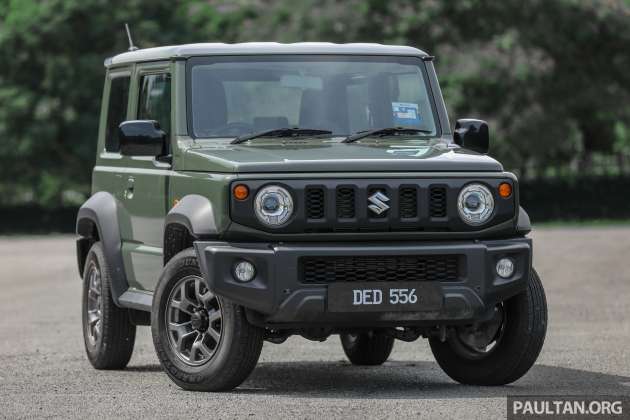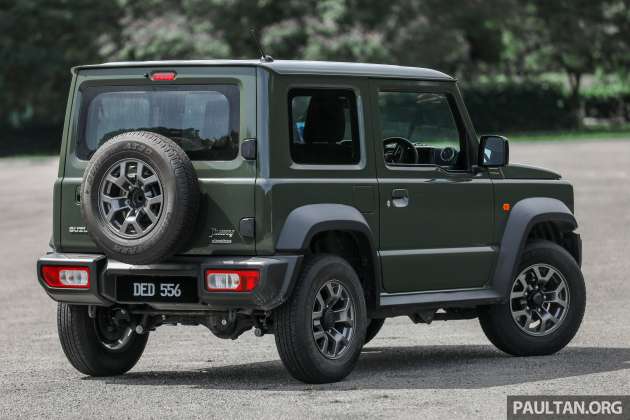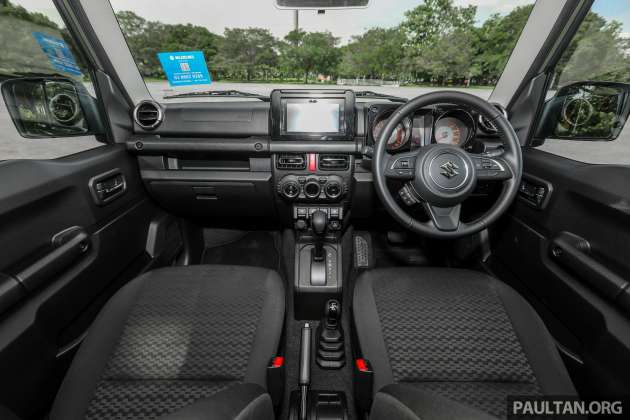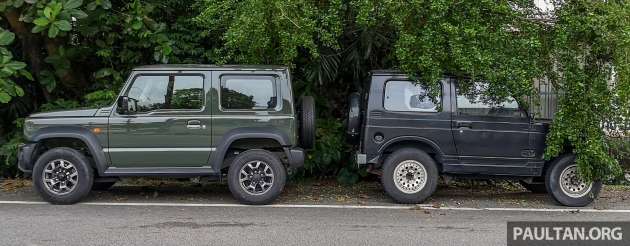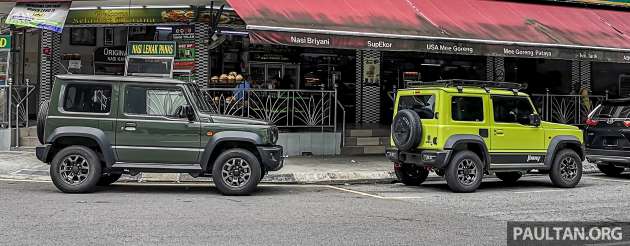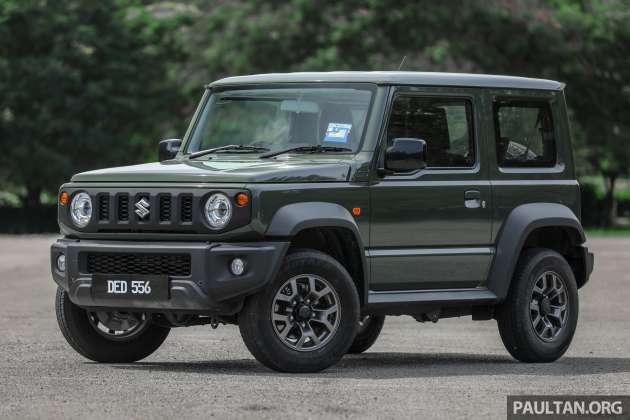The Suzuki Jimny – what do you make of this? It could have been three very different answers, depending on when the question was posed over the weekend that I had this intriguing little thing.
You see, normally, we sort of know what to expect from a test car, and surprises – if any – are still largely within expectations. Some cars are better than expected, some less so, but it’s all within the box. Modern cars are pretty homogeneous and it’s not often that something blows our minds.
With the Jimny, this writer went through three phases over three days, where I saw the Suzuki in changing lights. DED 556 ended up as one of the most memorable test cars I’ve ever had, and here’s my journey.
Phase 1 – Preconceptions
The fourth-generation Jimny was an instant hit when it debut in 2018. A retro reissue with hints of the immediate past model, but carbon copying the second-generation SJ’s shape (the one that everyone remembers), the JB manages to be authentically Jimny, but looking like a scaled-down two-door Mercedes-Benz G-Wagen at the same time. The same boxy proportions and angles as the now-hip luxury 4×4, but in kei-car size. Tough but cute, how on earth?
Like most fellow admirers, my infatuation with the Jimny was via the computer screen, but it was solidified at the 2019 Tokyo Auto Salon, where the little off-roader was the muse of every tuner, from serious performance outfits like HKS to hype brands like Liberty Walk. And who can forget DAMD, the company famous for its Little G and Little D makeovers. That’s the G-Class and classic Land Rover Defender, if you’re wondering.
This fool fell for the hype, but there’s trend. I’m a small car guy, and have been lusting over little Suzukis for awhile now. The Ignis is one of just a few cars from the Indonesian market that I wish I could buy here, and the JDM Alto – even in base form, never mind the Works – tickles my kei car fancy. But the Jimny is on a next level of cool. Like those cars, it’s a quirky little design, but with heritage, authenticity and even mainstream street cool thrown into the mix.
It was with this lens that I welcomed our Jungle Green tester. It was the wettest weekend ever, the one with the floods. I would be expecting modest on-road grip on the driest of days, given what the Jimny is, but looking at those skinny tyres and then the sky, a bit of apprehension crept in.
Phase 2 – Reality check
The Suzuki Jimny is no poser. It may look cool and it may be tiny, but make no mistake, this is a real off-roader, a relic from a time where there were no SUVs, just 4x4s.
If you’re old enough, you might remember the era of Pajeros and Troopers. This was before soft-roaders like the Toyota RAV4 started a revolution, before the Perodua Kembara brought 4WD to the masses. Then, 4x4s were for serious people who had serious use for their machines, gyms were for bodybuilders and running was a niche passion.
There’s nothing quite like the Jimny – a pint-sized off-roader that’s not priced like a house – on sale today, and come to think of it, the Kembara was the last such car if you discount the previous-generation Jimny. Today, every other car on the road seems to be an SUV, and the contrast between the Jimny and regular SUVs are stark and immediate.

Even I drive one of those things today. My daily is the Perodua Ativa, which is the Daihatsu Rocky. Once upon a time, the Rocky was a two-door serious off-roader like the Jimny. Malaysians of a certain vintage might remember it as the Daihatsu Feroza (bonus points to those who remember the TV ad’s jingle). My uncle, whose pastime is hunting, had one. The Rocky and Jimny were rugged brothers.
The picture above of the Jimny and Rocky side-by-side shows the path not taken, and what might have been for both small car specialists had they gone down the other road. If I had to choose one thing to symbolise the divergence, it’s the difference in windscreen rake.
That’s also the first thing that hits you when you jump into the Jimny from a regular car. It’s a glasshouse, and visibility is supreme, thanks to the big and upright glass panels, and those near 90-degree A-pillars. The Jimny is a box, and its extremities are obvious – just as well, because there are no reverse sensors, never mind a camera.
This is an interior of a kei car, which is what the Jimny is in Japan, where it goes without the chunky fenders/wider bumpers and 1.5L NA engine that the rest of the world gets (kei cars are 660 cc by regulation). It’s cosy, but somehow avoids feeling too cramped; perhaps it’s the glasshouse effect and ample headroom at play.
But it’s sparse. The second thing that hits you is the lack of amenities that are almost a given in cars priced a quarter of the Jimny’s RM168,900 RRP. By the way, that’s with sales tax exemption, and before the RM2,500 needed for the signature yellow paint with black roof.
The key is a twister with lock/unlock buttons on it. There’s auto air con, a touchscreen head unit, Bluetooth, automatic LED headlamps (which are too sensitive) and not much else. The two speakers produce tinny sound, but at least there’s Bluetooth and Apple CarPlay. Cruise control is a surprise addition. That’s your lot for RM170k.



There’s also a paucity of space for your stuff. Two cupholders and one hole between the seats are it, as the door pockets are very narrow. If I had a Jimny, I’d buy a few cubbies to hook on the passenger grab bar on the dash, which is very sturdy. That bar, and the binnacles for the dials, have “exposed bolts” for a tough look. The materials are more tough than plush (and there’s plenty of exposed metal), but you won’t want it any other way in a Jimny. Some recalibration is needed if you’re coming from most cars.
Then I go for a drive, and memories of the rental SJ410 when holidaying in Phuket ages ago resurfaced. To say that the 2021 Jimny drives like that old jalopy is exaggerating, but the way the modern Jimny gets going resembles more of that old timer than a modern SUV. For those who have memories of the Kembara, it’s something like that.
The 100 hp/130 Nm K15B-powered Jimny is slow, and getting up to speed with that four-speed auto takes some effort. It seems to be most comfortable at a 60-90 km/h cruise – 110 km/h feels fast here, and no wonder, when top speed is quoted at 140 km/h. I’m really curious how the 660 cc JDM version compares.
The Jimny’s steering (recirculating ball, power assisted) is high-geared and you’ll have to apply more angle than usual – this is expected for something designed to go off-road. That, and the jiggly ride from the ladder frame underpinnings, are the biggest reminders that this Suzuki ain’t no car-based SUV. I’m fine with that, but less bearable is the rear end that hops and thuds over bumps.
Given all the agricultural traits above, one part that exceeded my expectations is NVH. Insulation from engine and wind/road noise is decent, and that makes a big difference in daily liveability. Once you’ve adapted to its slower pace and body movements, the unexpected refinement means the Jimny is workable as a long distance car – in fact, I found the powertrain to be less buzzy than the latest Proton Iriz/Persona at a highway cruise.
If only my left foot could fit. The width of the transmission tunnel meant that I couldn’t place my idle left foot in a natural position, resulting in restlessness. Otherwise, the Jimny’s driving position (no telescopic steering adjustment) and ergonomics are fine by me.



The Jimny is not the kind of car to test cornering grip in and I did not make any attempt, not during the wettest weekend ever. It was a slow and steady stint for me and Suzy, and the goal was for us to survive the treacherous conditions unscathed. In the name of research, I entered a bend or two slightly faster than what would have been natural, and came to the conclusion that body roll is a safety feature in this car, a good deterrent from pushing hard.
What I did attempt however, is stuffing the family in. The slow Sunday drive (literally) proved that it’s possible to ferry three others; you’ve just got to ensure that there’s minimal shopping involved. With the rear seats in place, there’s precious little boot space, a lot less than in B-segment hatchbacks. What’s nice is that the rear seats are easy to fold and lift, and they have a robust, easy-to-clean plastic back surface. Think of it as a two-seater with a space that can switch between boot and seats.
Phase 3 – I could get used to this
Little did I know that there would be a third phase. I started to like the Jimny, warts and all, and despite the fact that I didn’t use any of its acclaimed off-road ability. If I did, at least the on-road trade-offs would be more “worth it”. This car is severely compromised as an urban runabout, but beware its charms.
The looks play a big part. Suzuki came up with something special here, a design that somehow manages both extremes – it’s retro yet modern, butch yet cute. And a new look is just a grille swap away due to the already “correct” box shape – Suzuki’s own classic mesh grille brings a BJ40 Toyota Land Cruiser vibe, and I prefer it over the G-Wagen and old Defender mods, but all are cool. Will one get giggles with “LITTLE D” emblazoned on the bonnet? Only one way to find out.
The lack of amenities is obvious, and some are harder to get used to than others (twist key is a real hassle), but I’ve always had old cars around so the lack of digital everything is somewhat easier to adapt to. Ditto the lack of space and two doors for a coupe guy.
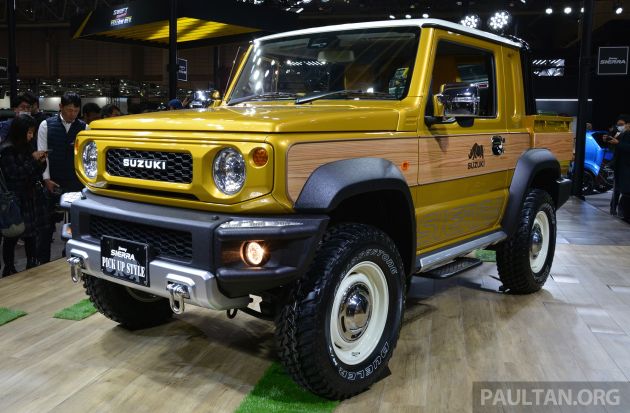

Raincoat on, windows rolled down, arm on the (super thin) sill, cool weather, typical Jimny slow pace – it was then that I realised I actually do this quite often (minus the arm thing), and we’re on the same wavelength. It could have been different if the weekend was hot and hectic, but there’s a charm to how basic and throwback the Jimny is. The experience reminded me of another car that seemingly has zero connection to the Suzuki.
That car is the Mazda MX-5. Both are tiny, impractical Japanese toys; both are fun things you buy for yourself with little concession to others; both lack a premium badge to impress people – where they differ is the kind of satisfaction provided. The Jimny is for the hipster who prefers a slow pace, and the outdoors.
Like the MX-5, the Jimny is seemingly poor value. If you view this car from an objective POV, it’s a poor buy. Has there ever been a new car with so little kit, space and power for RM170k? Yes, it can go off-road, but so can a fully-loaded pick-up truck – thrice the size, lower price and now with good safety features too. I can’t imagine off-road kakis paying RM170k for a new Jimny, not when they know how much it used to cost.

What about normal folks looking for an SUV? I can imagine them being visually attracted to the Jimny, but it won’t take more than a spin around the block to realise that the Suzuki is far removed from normal car manners and standards.
Who’s left then? Honestly, I don’t know. But if I would hazard a guess, it’ll be those looking for a quirky toy and love the Jimny’s looks. They could also be novelty hunters looking for an eye-catching baby G-Wagen. What’s for sure is that these folks will have at least another ride at home, one that does the daily grind well. Much like those buying an MX-5, but of a different bent.
With this price-content ratio, the Suzuki Jimny is a toy, a charming new-old car that not many will get, literally and figuratively. But if you do, you’ll be smiling most of the way, arm hanging out.
Source: Read Full Article

